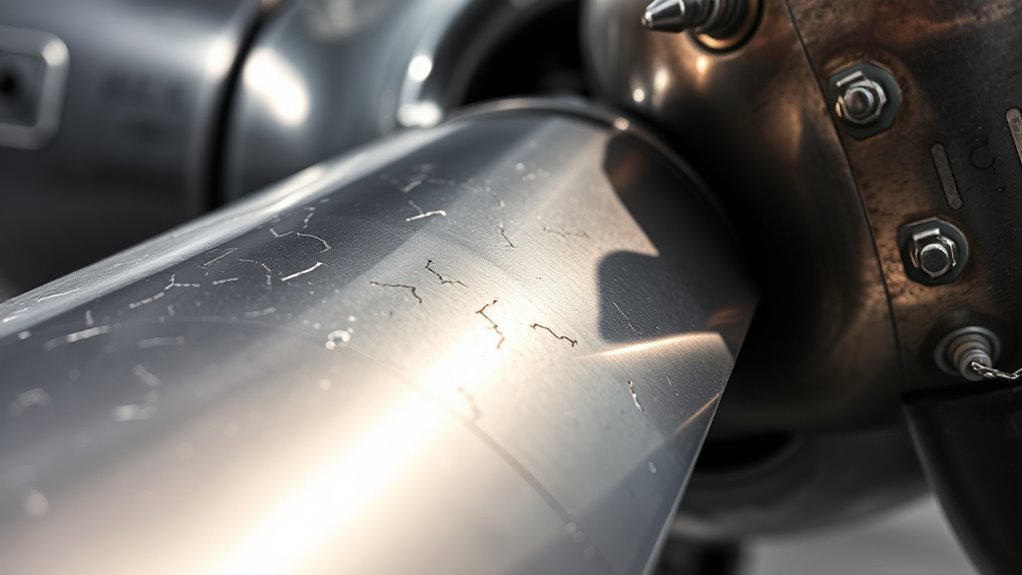To find micro-cracks in propeller blades, you need to use advanced non-destructive testing methods like ultrasonic and eddy current inspections. Visual checks alone often miss these tiny flaws because they are hidden beneath the surface. Regularly performing these detects early signs of material fatigue, preventing dangerous failures. Proper inspection techniques save lives and keep your aircraft safe. Keep exploring to discover more about how these methods work and why they’re essential.
Key Takeaways
- Regular inspections using advanced techniques like ultrasonic testing detect subsurface micro-cracks invisible to the naked eye.
- Non-destructive methods such as dye penetrant and eddy current inspections reveal tiny surface cracks before they expand.
- Material fatigue over time causes micro-cracks; early detection prevents catastrophic blade failure.
- Visual inspections alone are insufficient; combining multiple non-destructive testing methods improves detection accuracy.
- Adhering to industry standards ensures effective identification and timely maintenance of propeller blade micro-cracks.

Have you ever wondered why regular propeller blade inspections are essential for aircraft safety? It’s because those blades endure constant stress and environmental exposure, making them susceptible to material fatigue over time. Material fatigue occurs when repeated cycles of stress weaken the metal, which can lead to tiny cracks forming that are often invisible to the naked eye. If these micro-cracks aren’t detected early, they can grow larger and compromise the integrity of the blade, increasing the risk of catastrophic failure during flight. That’s why thorough and systematic inspections are necessary to catch these small flaws before they turn into major problems.
When it comes to identifying micro-cracks, you rely on advanced inspection techniques designed specifically for this purpose. Traditional visual inspections, though useful, often fall short because they can’t detect subsurface flaws or tiny cracks that are hidden beneath the surface. Instead, you turn to non-destructive testing methods, such as dye penetrant inspections, ultrasonic testing, or eddy current inspections. These techniques allow you to examine the blade’s surface and subsurface areas without damaging or removing the part, providing a detailed view of its internal and external condition. For example, ultrasonic testing can detect cracks at a microscopic level by sending high-frequency sound waves into the material and measuring how they reflect back from flaws. Similarly, eddy current testing uses electromagnetic fields to identify surface cracks and corrosion, which are common precursors to more severe damage. Additionally, understanding the importance of material fatigue helps you recognize the early signs of potential failure, ensuring that maintenance is performed proactively.
Using the right inspection techniques is crucial because it enables you to identify micro-cracks early, preventing them from developing into larger, more dangerous flaws. Regular inspections with these advanced methods help you monitor the health of the propeller blades, making sure that any signs of material fatigue are caught well before they pose a safety risk. It’s also essential that you follow the manufacturer’s guidelines and industry standards for inspection intervals and procedures. Doing so guarantees you maintain aircraft safety, compliance, and peak performance. If you notice any anomalies during these inspections, it’s imperative to take immediate action—whether that’s repairing, reconditioning, or replacing the blade—to mitigate the risk of failure during operation.
Frequently Asked Questions
How Often Should Propeller Blades Be Inspected for Micro-Cracks?
You should follow the recommended inspection frequency outlined in your maintenance scheduling to catch micro-cracks early. Typically, blades need inspection every 300-500 flight hours or during scheduled major maintenance, whichever comes first. Regular inspections help prevent blade failure and ensure safety. Always adhere to manufacturer guidelines and consult maintenance experts to determine the ideal inspection intervals for your specific propeller blades.
What Tools Are Most Effective for Detecting Micro-Cracks?
Oh, the thrill of micro-crack detection—truly the spy game of aviation! You’ll find ultrasonic testing to be your sharpest tool, revealing hidden flaws with sound waves. Magnetic particle inspection also proves invaluable, highlighting cracks that lurk beneath the surface. These techniques, when wielded expertly, guarantee your blades stay mission-ready, preventing catastrophic surprises. Embrace these methods, and you’ll master the art of micro-crack detection with finesse and precision.
Can Micro-Cracks Be Repaired Without Replacing the Blade?
You might wonder if micro-cracks can be repaired without replacing the blade. In many cases, blade repair is possible through crack mitigation techniques that involve precise welding or composite patching. These methods help restore blade integrity and extend service life. However, you should always consult manufacturer guidelines and a qualified technician, as some cracks may require more extensive repair or full replacement to guarantee safety and maximum performance.
How Do Environmental Factors Influence Crack Development?
Imagine your propeller operating in a coastal environment, where saltwater accelerates corrosion effects and temperature fluctuations cause metal expansion and contraction. These environmental factors promote crack development by weakening the blade material over time. Corrosion effects can create initial flaws, and temperature variations can worsen them, leading to micro-cracks. Regular inspections are essential, as these factors considerably influence crack progression and the blade’s structural integrity.
What Are the Safety Implications of Undetected Micro-Cracks?
If you ignore undetected micro-cracks, you risk material fatigue that can lead to catastrophic blade failure. This jeopardizes safety, causing potential engine damage or accidents. Regular inspection intervals help catch these cracks early, preventing safety hazards. Without proper detection, micro-cracks can grow unnoticed, compromising the propeller’s integrity and endangering lives. Stay vigilant and adhere to inspection schedules to guarantee safe operation and avoid costly repairs.
Conclusion
Regular propeller blade inspections are vital for catching micro-cracks early and preventing big failures. Did you know that studies show over 60% of propeller failures are linked to undetected micro-cracks? By staying vigilant and using advanced inspection techniques, you can greatly reduce risks and keep your aircraft flying safely. Don’t wait for a visible problem—early detection saves money, time, and lives. Keep inspecting, keep flying safely.










